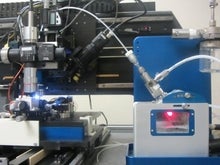Background
Graphene, as a 2-dimensional crystalline allotrope of carbon with
exceptional electrical and mechanical properties, has attracted many
researchers and industrial sectors to adopt it as a potential alternative to
traditional metallic elements for printed electronics, interconnects and
semiconductor applications. Flexibility of the 2D or 3D printed graphene
interconnects is one of its most important advantages. Graphene, once
printed, can be deformed without negatively affecting its performance. So
graphene is an ideal candidate for flexible electronic components and
development of printing processes of graphene is necessary.
Description of the invention
The present research combines the advantages of graphene and additive
manufacturing (AM) by integrating graphene in a micro-scale aerosol-jet
AM process. To print graphene patterns, a high-concentration graphene-based ink, compatible with the AM system, was developed using a chemical exfoliation process. This ink, with a graphene concentration of 3.1 mg/mL and a viscosity of 20 cP, comprises graphene flakes with lateral
dimensions below 30 nm, ethyl cellulose as a stabilizer for graphene
flakes, and a mixture of solvents that are compatible with the printing
process. Subsequently, the graphene patterns with resistivity as low as
0.018 Ω.cm and widths ranging from 10 to 90 microns was successfully
performed. These patterns, which are the finest ever printed graphene
patterns, may develop miniaturized printed electronic applications of
graphene.
Advantages
Compared to other ink-based AM processes, aerosol-jet printing system is
capable of printing inks with a wide range of viscosity (1 to 1000 cP). So
printing inks with higher graphene concentrations, and consequently,
higher conductivity for printed interconnects is expected. Small droplet
sizes (1 to 5 micron) in aerosol-jet printing also result in micro-scale
graphene features as small as 10 microns in width. Different adjustable
parameters involved in deposition process results in manageable width for
the printed patterns.
Potential applications
Graphene printed patterns as the most flexible conductive printed interconnect can be used in different applications including but not limited
to:
- Flexible electronics such as flexible tablets and cellphones
- Supercapacitors
- Light emitting diodes (LEDs) in environments such as information displays and biomedical systems

Aerosol-jet printing system used for 3D printing of graphene interconnects
Aerosol-jet printing system used for 3D printing of graphene interconnects
Reference
8810-7407
Patent status
US Patent 10,400,119
Stage of development
Prototype
Ongoing research
Contact
Scott Inwood
Director of Commercialization
Waterloo Commercialization Office
519-888-4567, ext. 43728
sinwood@uwaterloo.ca
uwaterloo.ca/research